Nursing Injured Creatures Back to Nature
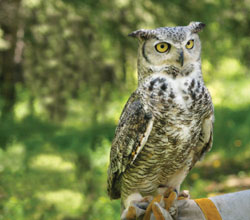 |
|
Photo by Terri Mason |
“There’s something in the trap,” Max Bott said to his friend, Ken Pattison, who had joined him on a balmy spring day to check his trapline in the Alberta foothills.
As the two outdoorsmen warily approached, the exhausted mature golden eagle fluttered weakly – then was still. Rather than subscribe to the now-notorious ‘shoot, shovel and shut-up’ theory, they draped the injured bird with a jacket, placed it in a box on the back of their quad and took it to the Medicine River Wildlife Centre.
The Medicine River Wildlife Centre, tucked amidst a half section of marsh and forest in central Alberta west of Innisfail, is Alberta’s largest wildlife hospital and education facility. The Centre began as the fledgling idea of its founder, Carol Kelly, after an injured owl came into the Red Deer SPCA where Kelly was a volunteer. “They didn’t know what to do with it,” she says.
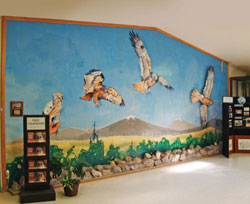 |
|
Photo by Terri Mason |
“My brother had given me a book by a woman in Ontario who rehabilitated owls,” she said. Kelly took the owl into her care and the next day the phone rang. “Fish and Wildlife called and said what I was doing was illegal,” she remembers with a laugh.
Instead of giving up the injured owl, Kelly asked government officials to make wildlife rescue operations legal in Alberta. With help from many sources, Kelly helped create the legal framework of contracts (now permits) to allow organizations to care for injured wildlife with the assistance of a veterinarian, quite literally making Kelly the mother of wildlife rehabilitation in Alberta.
The Centre, founded in 1985, treats more than 1,000 injured and orphaned animals each year and employs three full-time workers: Kelly; education co-coordinator Erin Young; and maintenance supervisor Todd Kelly. As well, the Centre benefits from eight wildlife rehab interns and four summer staff. It treats indigenous wildlife – “anything wild in Alberta,” says Kelly – and remains open 24-hours a day for emergencies.
Medicine River serves two roles – to educate the public on how to protect the natural world and to help injured wildlife. Not every creature survives or is able to return to the wild. Kelly says they’re happy that some 57 per cent of the animals brought in eventually return to their natural habitat.
 |
|
Photo by Erin Young |
The education side at Medicine River involves an interpretive centre and nature trail, open during the summer months. Either Kelly or Young, often accompanied by Otis, the Great Horned Owl, travels around the province to speak to audiences ranging from kindergarten to college students about wildlife rehabilitation and how everyone can make a difference.
Each year the need for the hospital, rehab and education centre increases as urban Alberta expands and more people come up against their wild neighbours. “We get approximately 8,000 phone calls a year,” says Kelly. “The more people, the more conflict between wildlife and people.” Vehicles, windows, barbed wire, electricity and domestic cats caused the majority of wildlife injuries seen at the Centre.
“We don’t preach, but sometimes I get surprising reactions when I give people the information about domestic house cats,” says Kelly. “Cats are not part of the natural environment; roaming cats are a real problem and cat populations are out of control. Cats are killing an estimated nine million songbirds a day.” (I double-check: a day? Yes, nine million a day, she confirms.)
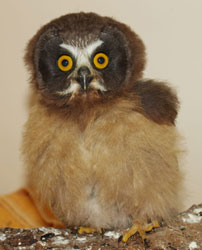 |
|
Photo by Erin Young |
“And that’s on some pretty sound research done by the Bird Conservancy. It’s not the coyotes or the magpies – it’s the cats. There was a study done in England and in areas where magpies are present, the songbird population was stronger.”
“We make a lot of assumptions in life,” she adds. “We see a magpie taking a baby out of a nest so we’re assuming they’re the cause. With other people, we hand them the information on the cats and sometimes the reactions are surprising. Recently, one person said to me, “Oh, that’s American research.”
No rehab centre in the province gets money for operations. They can apply for government grants to pay for educational equipment or to build a new cage, but operating funding simply is not available. Ironically, the Environment Canada website ec.gc.ca directs people to take injured animals to rehab centres they don’t fund. “It’s unfortunate because we do a great deal of work for Fish and Wildlife,” she says of the lack of government funding. “When they get a call about injured wildlife, very commonly they simply refer it over to us.”
I
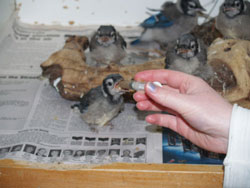 |
|
Photo by Terri Mason |
n conjunction with member-ships, donations and Adopt A Wildlife program, this governmental parsimony and ongoing bafflegab leads to high-flying ideas about fundraising, including bringing over Canadian funnyman Rick Mercer to speak at this year’s sold-out dinner and auction in Red Deer – to both help pay off Medicine River’s $300,000 mortgage and to preserve wild habitat. Large oil companies – Shell, EnCana and ConocoPhillips – each donated $10,000 to cover Mercer’s appearance fee, plus more. Kelly estimates between $50,000 and $60,000 was raised. “Not only did it raise money, it raised our profile,” Kelly said.
Suddenly the front door to the Centre swings open and a scruffy, youngish man in tattered work clothes enters, cradling a white tail fawn in his arms. “I saw him on the side of the road,” he says as the staff spring into action. “His mother was hit by a car.” The weak fawn, one eye swollen, is whisked into the hospital, examined, given fluids and placed in a small stall with two other nicely-recovering white tail fawns.
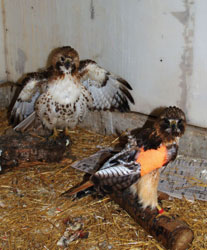 |
|
Photo by Terri Mason |
And so it goes. Not only each day, but each hour, brings something new. The staff appear professional, compassionate and experienced as they quickly assess and stabilize the animal with minimal handling, then place it in a quiet area to recuperate, often with others of its own kind.
Erin Young joins us; she has just finished her presentation for a giggling, wiggling mass of school kids. The showstopper? Otis, their resident Great Horned Owl.
Now the picture of glowing health and confidence, Otis came to live at Medicine River after a farmer found the injured chick in a field. “He was three- or four-days old. We think that he was stolen from his nest by a predator like a hawk or a falcon,” says Young. She surmised the chick might have fallen from the predators’ talons as the chick was found far from any trees.
The chick was bruised and bleeding internally when he came into their care. “Normally we would repair the chick and get them back into the wild, but in this one case we chose to keep him as an education owl,” says Young. “As his eyes opened he imprinted on us. He’s comfortable travelling and he thinks he’s a human.”
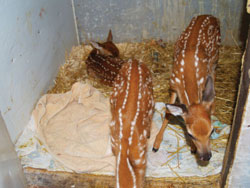 |
|
Photo by Terri Mason |
Young and I traipse down the shaded trail to the massive, towering raptor enclosure. The ingenious free-flow air design allows the building to be cordoned into four chambers, separated by large slatted doors. Today the building is wide open; they have the run of the place. The interior is cool, quiet – and a little ripe. The earthen floor is littered with the remains of, well, lunch. Spring was late in coming, Young explains. “It’s been so wet we haven’t been able to get in here to clean. Move slowly and be careful where you step, there’s a deer carcass over there.”
In the corner, about 25 feet off the ground, a healing bald eagle peers at us intently from the roomy enclosure. A handcrafted part-ladder/part-ramp, firmly affixed to the box, angles down to the ground. I avoid the scattered chicken feet as I crane my neck for a better look. He’s haughty.
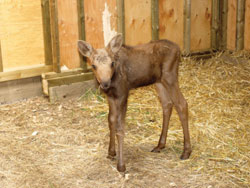 |
|
Photo by Erin Young |
Slowly, we back out and head to the other quarter. “There’s a golden eagle in here,” Young says. We enter; there’s an explosion of sounds. Hawks, with wings that will never soar again, take half-flight to their part-ramp, part-ladder perch. Wings, talons and beaks are employed to scamper up to their enclosure. “Hawks are more skittish,” Young adds. “They are more excitable but they won’t hurt you. They might bump into you but they won’t attack you.” We stand stock-still, settling the hawks and trying for some most-difficult lighting photography. They are wary and wild, wild, wild.
The golden eagle stops, almost posing. I ask hopefully: “Is that the eagle Max and Ken brought in?” “No,” Young replies. “He didn’t make it.” We quietly back out and firmly shut the door.
Back at the hospital, the white tail fawn is curled up and asleep. His two companions – with their impossibly thin pogo-stick legs – sproing about in some joyous fawn-game. Young leads me into raptor rehab. A male Red Tail hawk, his broken wing bandaged in bright orange, and his female companion stare at us defiantly. “She is a foster mom,” Young says. “Look behind her.” Almost hidden are two Red Tail chicks peering out at us. “They ran right to her,” Young laughs. “She didn’t know what to think.” Fostering helps youngsters learn the skills necessary to go back to their wild homes.
I
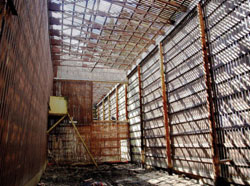 |
|
Photo by Erin Young |
t’s feeding time. Bluebirds, blue jays, starlings, sparrows – the throats of a myriad of songbirds – take up the call. A cage door is opened and hospital coordinator Raquel Lukye syringes a bird delicacy into each gaping maw. “There’s always a runt and I have to make sure they get fed too,” she explained, gently touching the beak of a little one with the syringe. The beak pops open, lunch is over.
Today, thanks to the efforts of Carol Kelly, some six to eight wildlife facilities obtain permits each year across the province. The recipient of numerous awards, including the prestigious Alberta Order of the Bighorn, Kelly waxes philosophical about the Centre.
“Through our centre and our education programs, we encourage people to learn and open their minds to change. I know sometimes it’s difficult to change, yet I see ranchers out there living in cooperation with nature.
“I had a sheep farmer bring in an injured coyote pup and I said to him, “Holy, man, I’m impressed.” I didn’t think there were any sheep farmers that would give the time of day to a coyote,” says Kelly. ‘I don’t mind the coyote, they need to be here,’ he said. ‘I have a donkey and since I put (him) with the sheep I haven’t had a single loss.’ How simple an answer that is.
 |
|
Photo by Erin Young |
“We encourage people to find proactive solutions to live together as opposed to reactive solutions,” adds Kelly. “I think we’re in a generation where we can do that.”
Kelly promotes taking steps to live at peace with the wild, such as protecting windows against bird strikes, replacing barbed-wire fencing with high tensile steel, being more aware while driving and not letting domestic dogs and cats roam uncontrolled.
Her philosophy is the Centre’s philosophy: “We try not to preach. We don’t say, ‘You’re bad.’ We say, ‘Here is the information, we’ve done the research,’ and then you can make an informed decision.”
“In the 24 years I’ve been doing this I’ve seen a complete change in the way the general public looks at wildlife,” says Kelly. “The calls we get now are not ‘this animal is a nuisance can you come and kill it,’ to ‘this animal is causing me some problems, how can I address this?’ We’re seeing this, especially in the younger generation,” she laughs. “So the older generation better keep up with the kids!”
That evening, back home on the ranch, I ride by the yellow barn cat crouched in the ditch and I ponder Kelly’s words; nine million song birds a day…
